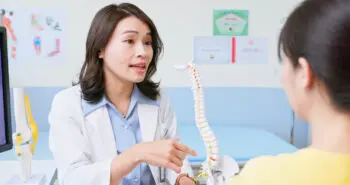Basic Anatomy of the Spine
The human spine, or backbone, is a marvel of engineering, providing both stability and flexibility to our bodies. It consists of 33 vertebrae stacked one on top of the other, divided into five regions: cervical (neck), thoracic (mid-back), lumbar (lower back), sacral, and coccygeal (tailbone).
Each vertebra is cushioned by intervertebral discs, which act as shock absorbers, allowing for smooth and pain-free movement. The disc is made up of a thick outer layer called the annulus fibrosus and an inner cushion called the nucleus pulposus. The spine’s ability to flex, twist, and support weight is crucial for daily activities, from bending to pick up objects to turning our heads.
Spinal Conditions That Limit Motion

Several conditions can impair spinal motion, leading to discomfort and reduced quality of life. These include disc degeneration, facet hypertrophy/degeneration, osteophyte formation, and neural compression.
1. Disc Degeneration:
Intervertebral discs are gel-like cushions between the vertebrae that provide flexibility and absorb shock. Over time, these discs can wear down, losing their height and elasticity. This condition is known as disc degeneration. This can lead to pain and reduced range of motion, as the discs no longer function effectively.
2. Facet Hypertrophy/Degeneration:
Facet joints are small joints located between and behind adjacent vertebrae. They help guide and limit the movement of the spine. With age or repetitive strain, these joints can become enlarged (hypertrophy) or worn out (degeneration), causing stiffness, pain, and restricted motion.
3. Osteophyte Formation:
Osteophytes, commonly known as bone spurs, are bony projections that form along the edges of bones. They often develop in response to joint damage caused by conditions like osteoarthritis. In the spine, osteophytes can reduce the space available for spinal nerves, leading to pain and restricted motion.
4. Neural Compression:
The spinal column surrounds and protects the spinal cord, and individual spinal nerves pass through openings in the vertebrae. Conditions like disc herniation (disc material protrudes out) or spinal stenosis (narrowing of the spinal canal) can compress these nerves. This compression can cause pain, numbness, and weakness, severely limiting function.

Image of Spinal anatomy, disc degeneration and nerve compression
Common Causes of Spinal Conditions
Understanding the causes of these spinal conditions can help in their prevention and management. The most common causes include:
Age:
As we age, the components of our spine undergo natural wear and tear. The intervertebral discs lose water content, becoming less flexible and more prone to degeneration. Similarly, the facet joints can develop arthritis, leading to pain and stiffness.
Overuse:
Repetitive motions or heavy lifting can strain the spine, leading to conditions like disc degeneration and facet joint problems. Athletes and individuals with physically demanding jobs are particularly at risk.
Genetic Predisposition:
Some people are more prone to spinal conditions due to their genetic makeup. A family history of spinal problems can increase the likelihood of developing similar issues.
Lifestyle Choices:
Certain lifestyle factors can contribute to the development of spinal conditions. Poor posture, obesity, smoking, and lack of physical activity can all negatively impact spinal health. For instance, excess weight puts additional strain on the spine, and smoking reduces blood flow to the discs, accelerating degeneration.
Conclusion
Maintaining spinal health is essential for preserving motion and quality of life. Understanding the basic anatomy of the spine and the conditions that can affect it helps in recognizing the importance of preventive measures and seeking appropriate treatment when necessary. Age, overuse, genetic predisposition, and lifestyle choices all play significant roles in spinal health. By adopting healthy habits, such as regular exercise, maintaining a healthy weight, and avoiding nicotine, we can support our spine’s function and reduce the risk of debilitating conditions.



